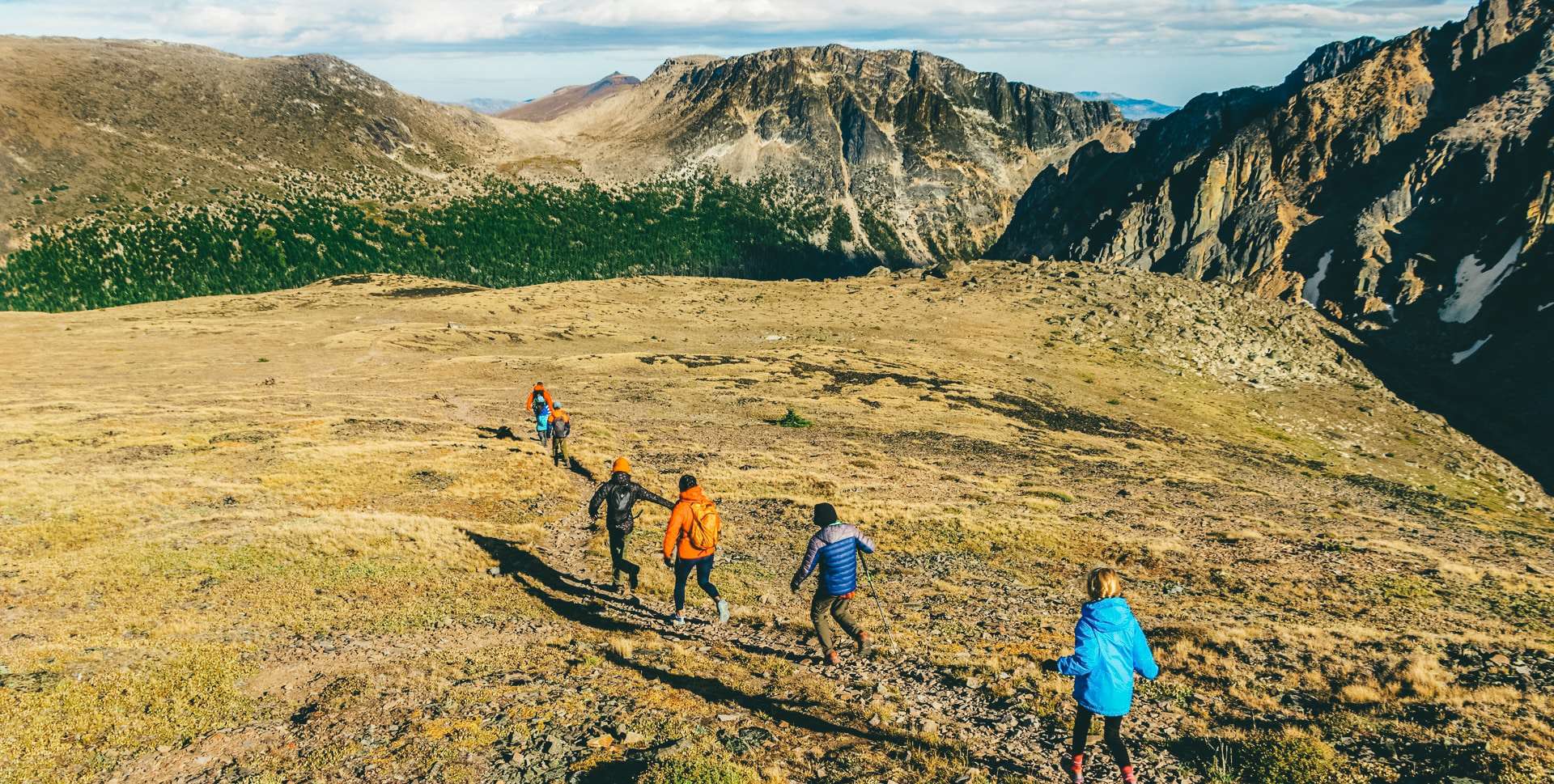Keeping the kids entertained for a whole camping trip might seem intimidating – but don’t worry! Thankfully, there are plenty of things you can do while camping to keep them occupied.
Whether you need some fresh ideas for your next trip or are looking for some inspiration for your first camping adventure, there’s plenty of activities here to keep you and the kids occupied.
Our camping activities for kids suggestions are split into different sections to make it easier to find the kind of activity you want. For games, I’ve also included a suggested player’s recommendation.
Related: Sometimes families need a tent that can act as a second home. Find out what the best family cabin tents are.
Big Activities
These are larger undertakings that could form the focal point of your day.
1. Go for walks and hikes
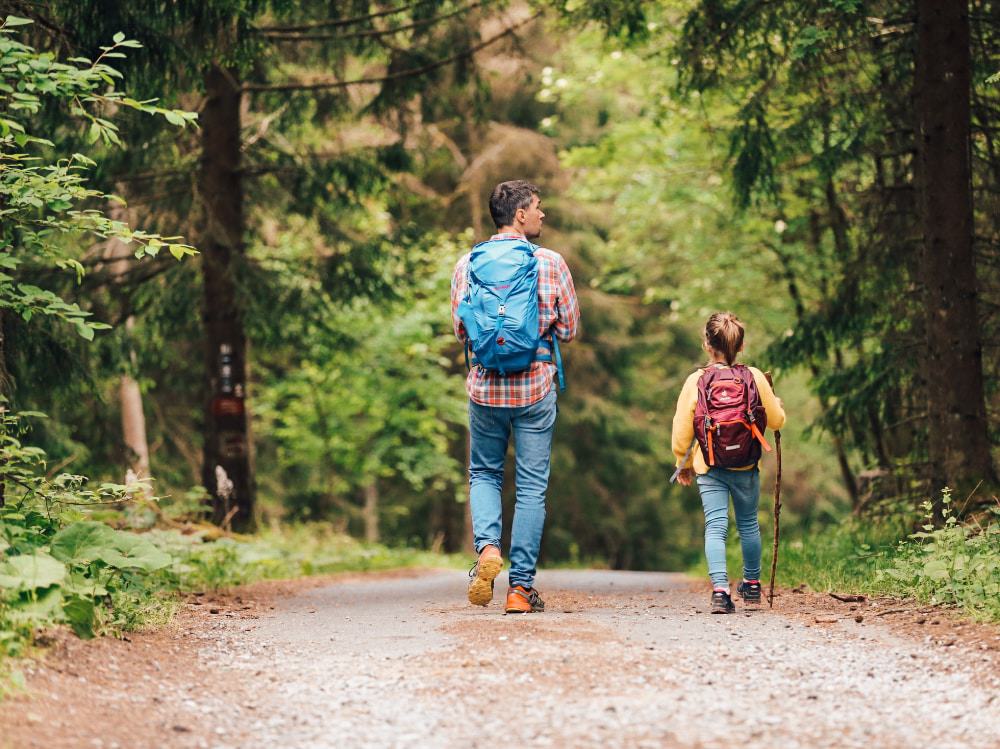
Hiking is a great way to let your kids explore the natural landscape. It’s also a great form of exercise and an opportunity for some family bonding!
As kids get older, it can be a good idea to try and get them involved in the planning process. Letting teenagers lead parts of hikes and make decisions nurtures their independence and outdoor skills.
Involve kids in checking the map when you’re out trekking. Don’t only show them where you are on the map but explain to them how you worked it out. As they become more experienced and more skilled at map reading and using a compass, you can start letting them lead the walk.
For younger kids remember that little legs can’t keep up for very long and will tire out quicker than you. Plan routes that aren’t very steep and allow for a slower pace with plenty of rests.
Tip: Positive reinforcement is important for kids who are starting to hike – tell them how well they are doing to encourage them to keep going
2. Teach them to fish
Fishing with kids requires patience – from both parent and child! It helps to teach kids about where their food comes from and can be an opportunity for some quiet family time together.
It’s also very popular among teenagers, with 8-in-10 going fishing while camping [1].
If it’s your first time taking the kids fishing, try to scout a location with plenty of fish to maximize your chances of catching something. It can be discouraging to kids if they don’t catch a fish but if no one in the family catches anything it will risk being boring.
Tip: Fishing without catching anything can be disheartening and even boring for kids so encourage them to explore the river bank if they get tired of casting – but make sure they stay in sight
Kids are curious so make sure to explain the process to them, like how to watch the float to use as a bite indicator. The better understanding kids have of fishing, the easier it is for them to see that like any skill it takes time to learn.
The U.S. Fish and Wildlife Service [2] have an excellent guidebook for teaching kids to fish if you need some help (there’s plenty of information in there for adults as well).
You can get small children’s nets that come with a handle which are great for catching small fish at the water’s edge. They are a lot easier to use than a rod so are ideal for younger children as well.
Related: Looking for a great camping experience for a large group? Check out our reviews of the best large camping tents.
3. Try out some watersports
In Scotland, we have an abundance of lochs that are great for all sorts of watersports. Campsites near water will often advertise watersports like water skiing, rafting or canoeing.
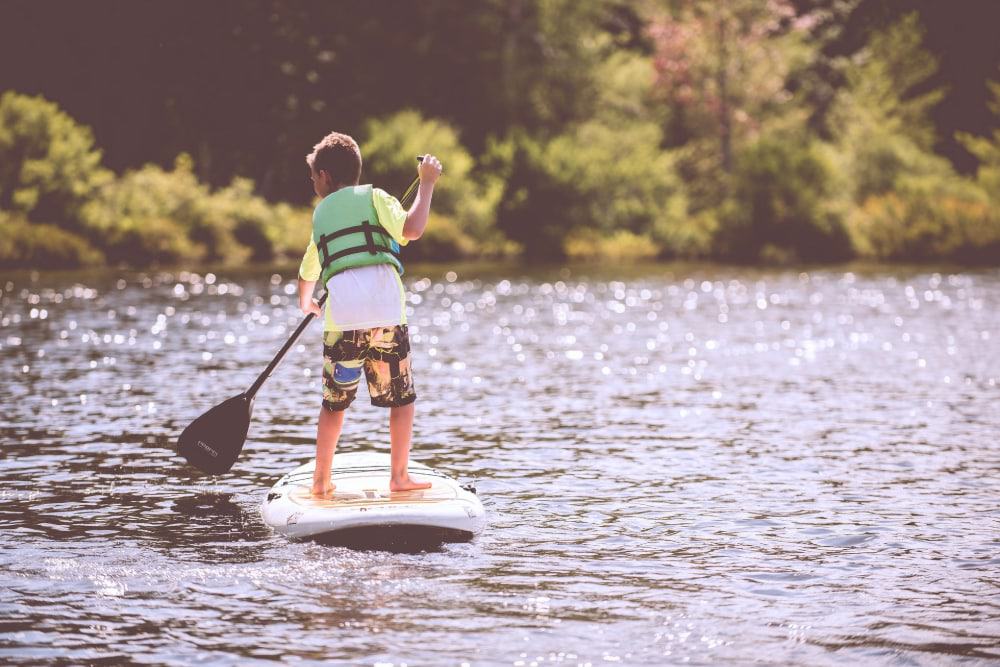
Watersports like canoeing can be a good way to make your kids feel comfortable around the water as well, especially if they are introduced from a young age.
Watersports will require some preparation. Whilst some activities like canoeing can be enjoyed without getting very wet, there are others that aren’t going to leave you quite as dry. Waterskiing or paddleboarding might mean you need to get wetsuits for the kids depending on the water temperature.
Wetsuits aren’t necessary for every watersport activity and you can hire them. But they let your kids play in the water for longer if it’s cold (as it often is in Scotland!).
Sandals or shoes that you don’t mind getting wet are also important to consider for some watersport activities.
4. Camping Olympics
Especially good fun with large groups, you can set up a “camping olympics” day with multiple events. If there’s a big age range of participants, maybe consider that when picking the events. You can either play in teams or as individuals!
Balloon Relay: Players split into two teams with a balloon for every player. Then they have to hop with the balloon between their legs to a chair (or a bench – whatever you can use) and pop the balloon by sitting on it, before running back to their team for the next player to go.
100m Dash: Pretty simple and doesn’t even have to be 100m, just set out a start and finish line and you’ve got your race track!
Obstacle Course: Bring some hoops for jumping through and maybe introduce some gymnastics like cartwheels.
Paper Plane Toss: A less physical competition everyone has a chance at. Just bring some paper for folding into airplanes, mark out a starting position and see who can throw theirs the furthest!
Dizzy Bat Race: This one’s really fun and simple. All you need is a couple of bats and something to mark out a start and finish line. Players at the start line have to place their forehead on the top of the bat with the bottom resting on the ground and then spin around a bat, keeping it in place, for ten (or more if you’re brave!) rotations. Then you just have to run to the finish line!
Easy, right?
Suggested Players: You need enough players to split into teams, I would recommend a minimum of six
5. Scavenger Hunt
Look up some local wildlife and plants for the area you’re staying in to help teach kids about identifying nature. For example, whilst Rothiemurchus Forest is dominated by Scots Pine there is also Aspen, Birch, Willow, and other trees you could include as part of the hunt.

Write items to collect in your scavenger hunt checklist like pine cones, leaves from an Aspen tree, and a good stone for skimming.
Tip: For younger kids learning colors, go on a color hunt to find items that match a color.
Outdoors Games
6. Kick The Can
Kick the Can is like a variation of tag or hide and seek. You need to place a can in the middle of a clearing and decide one person to be “it” to start with (drawing sticks is usually a fair way to decide).
The person designated “it” has to try and catch everyone else. Once caught, players go to “jail” (a predetermined area for holding – sometimes a bench) where they have to wait. They can be freed by other players kicking over the can before being caught.
Suggested Players: At least three players
Related: Pitching the tents can take away valuable time from your experience. Instant tents can massively reduce this setup time. Find out what the best instant tent are.
7. Capture the Flag
This one is better for bigger groups, so if you’re going with another family Capture the Flag is ideal!
Two teams have a flag each located in their base. The objective is to get the other team’s flag without getting tagged in their territory.
You can decide after players have been tagged if they are out of the game or if you’re going to have a “jail” like in Kick the Can
Suggested Players: Ideally you want two teams of at least four, so a minimum of eight players for a full game would be suggested
8. Wink Murder
Each round, one person is secretly assigned the role of murderer (you can draw straws or deal cards to decide) and must make eye contact and wink at their victims to “kill” them. Their objective is to kill all players without being caught.
After five seconds or so, the victim should feign death (be as dramatic as you want!) to let other players know.
The victims have to try and discover the murderer. Accusations can be made at any point of the game by announcing “I accuse” but players can’t discuss their suspicions with one another!
If the player guesses right, they win the round! But if they are wrong, then they “die” and are out for the rest of the round.
Suggested Players: This game works best with six or more players but can be done with a minimum of four.
9. I Spy
A classic game best used on a long hike or bike ride passing changing landscapes!
One player chooses an item they can see and says to the other players “I spy with my little eye, something starting with…” and gives the starting letter or sound of their word (f for “fence”, for example).
Suggested Players: Two or more players
10. Cornhole or Bean Bag Toss
Cornhole is a game where players throw small bags of corn kernels (or bean bags) into a hole at the end of a raised platform. You can have multiple holes that are worth different points.
You can use hoops or rings instead of a platform as well.
Suggested Players: Two players or four players split into two teams
11. Fire Tender
One player (the fire tender) sits blindfolded with sticks laid out around them. The other players have to creep up and steal a stick without making a noise. If the fire tender hears a noise and points in the right direction of the encroaching thief, they’re out!
Whoever has the most sticks at the end is the winner.
Suggested Players: At least three players and for larger groups consider splitting into two teams
12. Bear Catcher
One player is the catcher and the rest are bears. The bears each sit in their “cave” (sleeping bag) around the campsite with the catcher in the middle. On the word “go” all bears must run to a new cave before being caught!
Once a player is caught, they are out and must take their cave/sleeping bag with them. A new round starts until no bears are left.
Suggested Players: A minimum of four players
13. Skimming Stones
If you’re near a body of water, then skimming stones can keep the kids entertained for hours. Between finding the perfect rock and trying to nail their technique, kids (and big kids) will be kept happy for a while.
If you have already done your scavenger hunt, use the good skimming stone that was one of the items!
Suggested Players: Only requires one player but is more fun with others to make it a competition
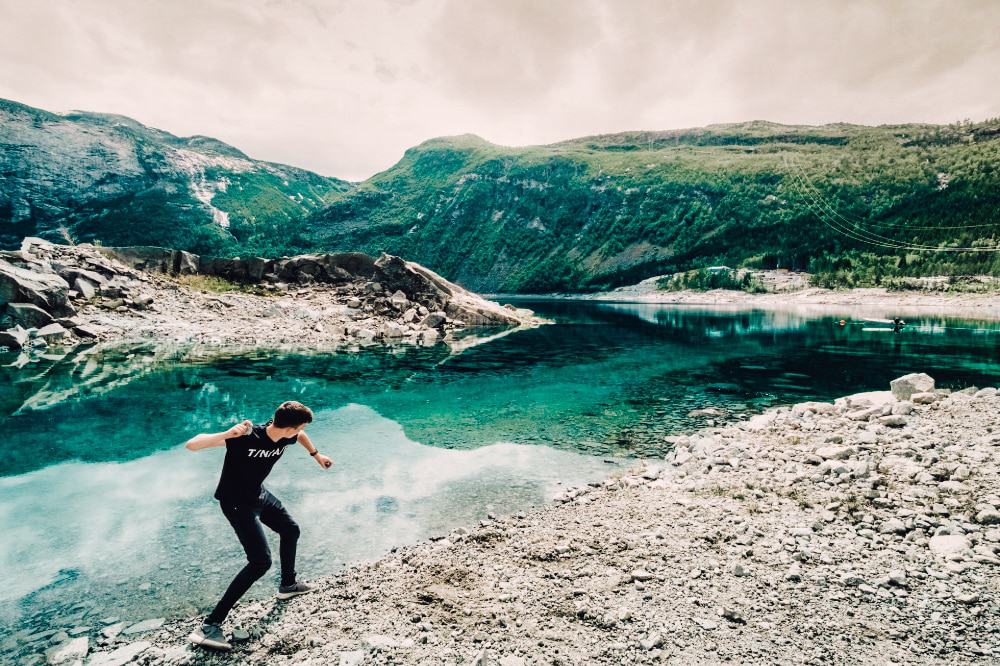
Tent Games
We can’t control the weather. Sometimes it rains. It’s not the end of the world but you should be prepared with some activities in case you have to spend some time in the tent and out of the rain.
13. 20 Questions
One player thinks of a mystery object and the other player has 20 yes-or-no questions to work it out.
For example, the player could be thinking of a bear. Other players can then start guessing questions to try and work it out, commonly starting with asking if it’s an animal (or vegetable, mineral or other).
Follow up questions might be:
- Is it furry?
- Is it dangerous?
- Is it multicolored?
Tip: For younger children, answering yes or no might be difficult if they aren’t confident about what they’ve picked so consider adding “maybe” or “sometimes” as answers.
Suggested Players: Minimum of two
14. Two Truths and a Lie
One player (the liar) comes up with a lie and two truths and the other player has to guess the lie.
You can decide amongst yourselves whether you want to allow people to ask questions of the liar or not. It usually can make things harder for the liar but can make the game more interesting as players try to keep up with their lie.
You can mix things up with two lies and truth as well.
Suggested Players: Minimum of two players but better with large groups
15. Charades
One player has to act out something without speaking whilst other players try and guess what it is they are miming. You can play in teams with points or individually just to pass the time. You can also decide whether players act out assigned answers or if they come up with their own.
For younger kids, it’s a good idea to keep the suggestions easy like “brushing teeth” or “swimming”.
Suggested Players: Three or more
16. Shopping Trip/Camping Trip
One player starts the game by saying “I went to the shops and I bought…” then lists an item beginning with A. The next player has to follow with their object of choice and add their own that starts with B. And so on.
I went to the shops and I bought… An apple, a banana, a carrot…
The game ends when a player guesses the next item wrong, can’t remember the next item or hesitates for too long before guessing.
Tip: Change the game to “I went on a camping trip and I brought…” for a fun twist
Suggested Players: Three or more players
17. Card Games
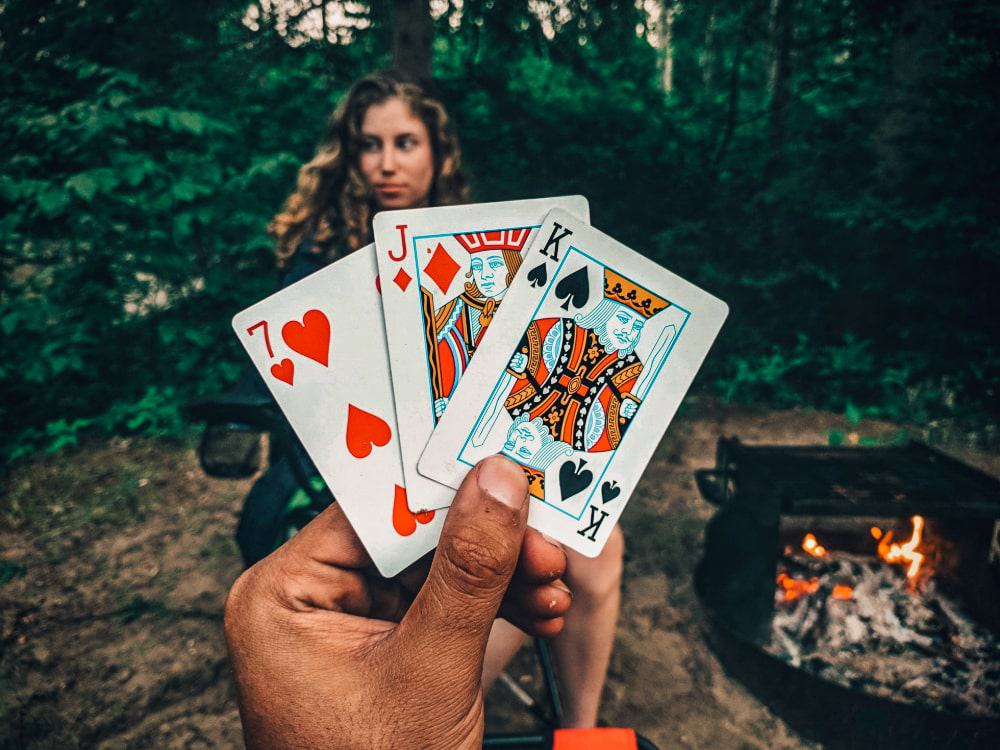
A deck of cards can be used for so many different games, so make sure to bring one! I’d recommend trying to learn a new game for every trip to keep things fresh. Go Fish is a camping classic but maybe try out spoons for your next trip! [3]
Spoons
Start each round with one less spoon than the number of players. Each player is dealt four cards and the aim is to collect a four-of-a-kind. The dealer starts by drawing a card from the top of the undealt pile, then passing a discarded card from their hand to the person on the left.
That person then discards a card from their own hand to the player to their left, and so on. Every player should start and end their turn with four cards.
The last player (the player to the dealer’s right) places their unwanted card into a trash pile by the undealt cards. If the undealt cards run out, shuffle the trash pile and then use it as the new pile to draw from.
Once a player gets a four-of-a-kind they can grab a spoon and reveal their cards. After one player has taken a spoon, all the other players have to try and grab a spoon before they’re all gone.
Whoever is left spoonless at the end of the round is out. Make sure to remove a spoon before starting the next round!

Suggested Players: Some card games like Solitaire can be played alone whilst other games like Spoons can be played with up to 13 people
18. Board Games
You can take a classic from home, borrow from one from friends or look in thrift stores for a cheap deal!
Board games for camping should be compact and durable without many small fiddly-bits that could get lost. Classic games like Yahtzee, Jenga or Uno are great for the whole family whilst Exploding Kittens is a fun game for older kids and grown ups [4].
Suggested Players: Whatever the box says!
19. Books
For a bit of quiet time, bring some books to keep the kids occupied. Books that have a focus on nature or the camping experience are fitting with the trip. Remember to take torches for all the kids so they have their own.
For toddlers and preschoolers, there are plenty of coloring books and illustrated books that cover camping like Curious George Goes Camping which deals with issues like fire safety [5].
A book of Mad Libs is also a good idea. It is a game where one player will ask the other to provide a noun, adjective, or verb or choose from a list of words to fill in blanks in a sentence. The first player then writes the suggestion in the blank space in the book and reads the story back.
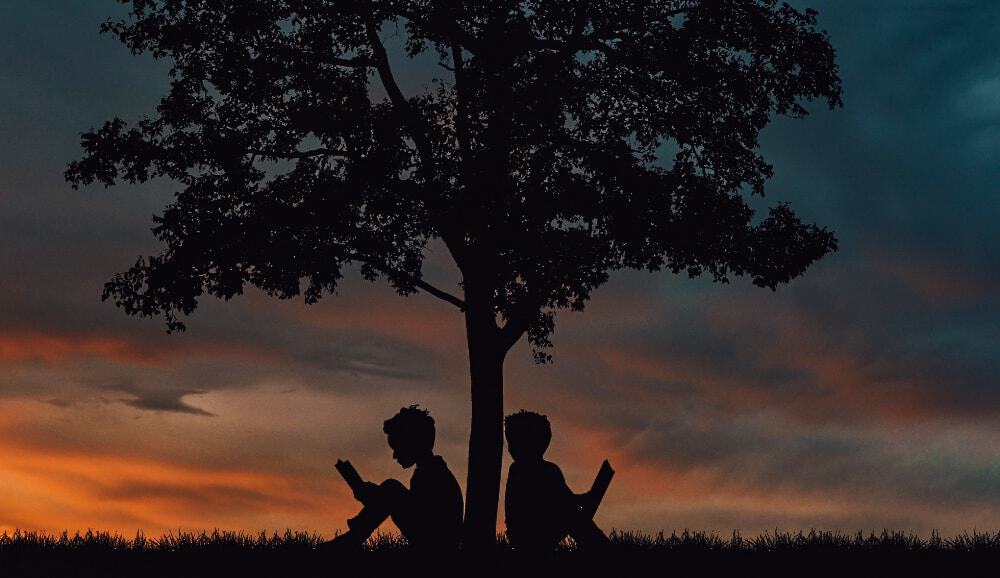
Night Time
20. Chubby Bunny
Whilst not necessarily a night time game, it’s the perfect game for nights sat around the campfire.
The objective is simple – see how many marshmallows you can fit in your mouth and say “chubby bunny” at the same time. The winner is whoever manages the most.
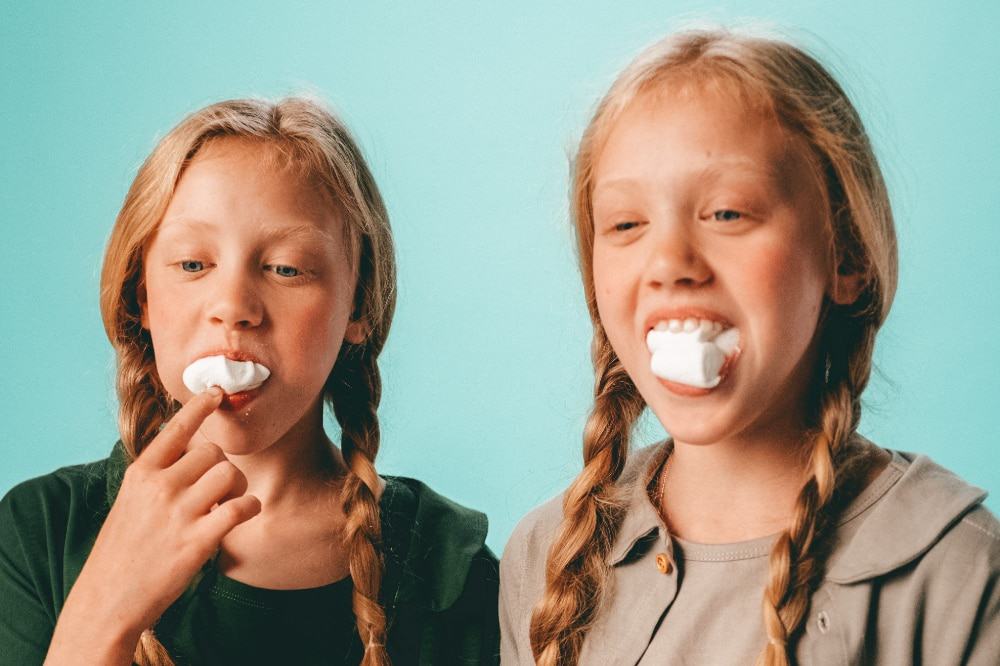
21. Flashlight Tag
One player is “it” and has to try and find other players in the dark using their flashlight.
Whilst it can be a really innovative way to play tag, make sure if you aren’t disturbing any other campers’ experiences!
Tip: Mechanically powered flashlights that require turning a crank or shaking the flashlight are an extra fun addition as they limit the catchers light source
22. Sing-a-Long
Singing songs around a campfire is a classic tradition – so get involved! Even if you’re not musical it can be a fun way to pass an evening.
23. Scary Stories
Spooky stories around a fire also usually go down a hit! Here’s some tips to make your campfire storytelling extra spooky:
- Explain how you personally heard the story – from a friend who used to live near the area, for example.
- Take lots of dramatic pauses and let the crackling fire heighten the tension
- Use an accomplice (another parent) to help out by hiding in the woods and shaking bushes and trees
- Know the kids you’re trying to scare – don’t over do it!
Tip: Make sure you’re not the one responsible for getting the kids to sleep after telling them the stories…
Smart Technology
Getting away from screen time is an important part of the camping experience for most people. But there are ways you can incorporate technology into your camping trip to make it even more special.
It might be important if you use taking screens away from kids as a punishment to still let them use their phones at times. Otherwise, they might feel like they are being punished!
24. Geocaching
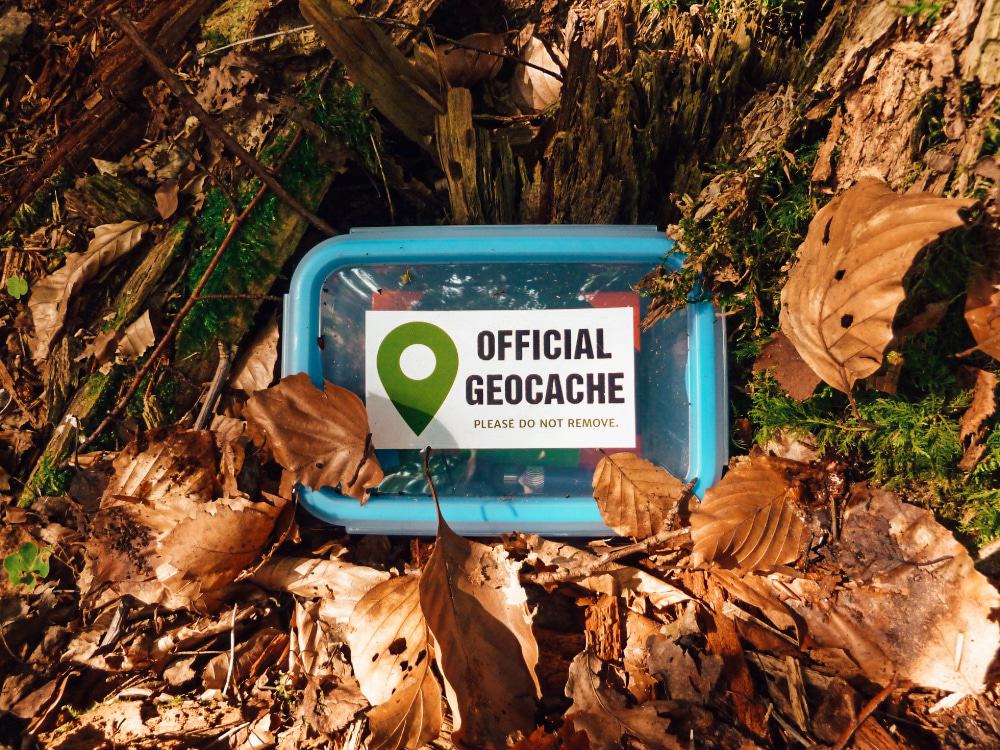
Geocaching is an outdoor recreational activity that involves using a GPS device (most people use their phones) to locate containers called caches or geocaches!
Geocaching is a form of exercise that involves the whole family in the great outdoors. For some, it’s the perfect activity for camping that blends modern technology with a natural environment.
Some people are critical of geocaching, viewing it as potentially damaging to the wilderness and a distracting blight among natural environments. This is particularly a growing concern with more people geocaching.
However, as long as you follow the principles of Leave No Trace and are respectful while geocaching, it can be a fun activity for the whole family.
25. Photography
Taking photos will leave you with snapshots of your trip and photography can open up a new artistic world to kids!
Just make sure they don’t spend the whole trip snapping away.
Tip: Encourage older kids to play about with the settings and practice to understand them better and take more professional photos
26. Star Gazing
Using apps like Night’s Sky [6] can help educate your kids about stars and planets leaving them with a greater appreciation for the experience. The app uses geo-tracking to show you what stars and planets are visible above your head at any time.
Tip: Trying to get your kids into camping? Check out our guide to camping with your kids.
References
[1] http://koa.uberflip.com/i/794160-2017-north-american-camping-report/0
[2] https://www.fws.gov/warmsprings/pdfs/WarmSpringsKidsFishBook2012FINAL.pdf
[3] https://bicyclecards.com/how-to-play/go-fish/
[4] https://www.trustedreviews.com/reviews/exploding-kittens
[5] https://www.commonsensemedia.org/app-reviews/curious-george-goes-camping-by-i-read-with
[6] https://apps.apple.com/us/app/night-sky/id475772902
Bonus Tip!
27. Playing House
Camping is a different setting and whilst chores are usually a pain, they can be exciting when camping! Kids will also feel like they are helping if you give them jobs to do around the campsite.
When you arrive at your campsite there will be lots of set up tasks you can get the kids to do, like clearing the tent area of stones before pitching the tent. Throughout your trip, there will be jobs to be done like collecting water for the camp.
Looking back on family camping trips and youth camps, I remember having fun collecting wood for the campfire. I wasn’t the only one either! There’s something about the outdoor setting that makes tasks that should be chores fun.
It’s important to make the kids feel like they are helping with camp life.
Tip: Looking to get into camping but prefer to camp in comfort? Consider giving glamping a shot!
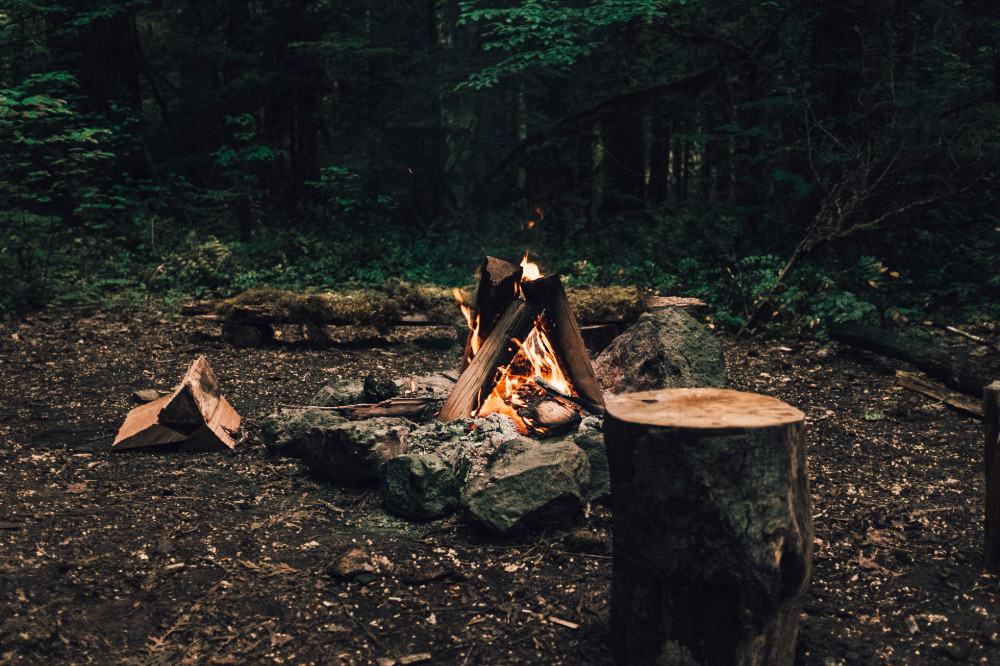
If your campsite allows it, a campfire is a great way to keep the kids happy. If you need some tips on building the perfect campfire, check out our guide on how to start a campfire.
Just remember to lay down the law about fire safety with your kids!
You can also bring some toys and equipment for less focused activities:
- Frisbee
- Water guns
- Binoculars
- Balls
- Paper and pen
- Chalk
Wrapping It All Up
The goal is to not only keep the kids entertained but also encourage personal growth through time well spent.
There’s plenty of things you can do to keep the kids happy while camping. But try not to over-plan your activities – make sure to leave some room for spontaneity and adventure!
So there you have it – 27 camping activities for kids! Happy camping 🙂
